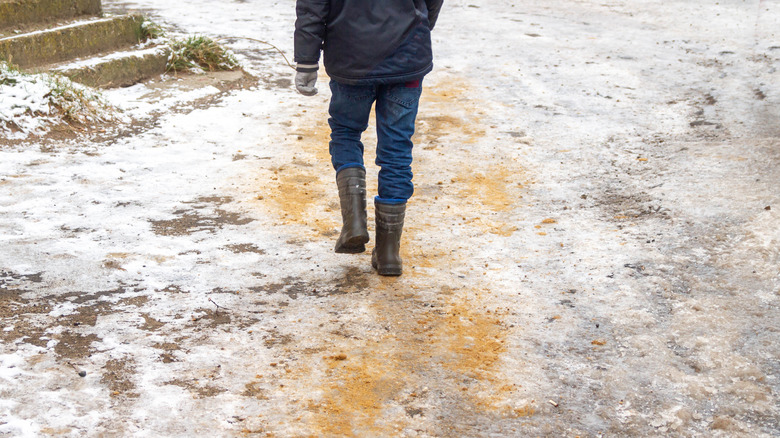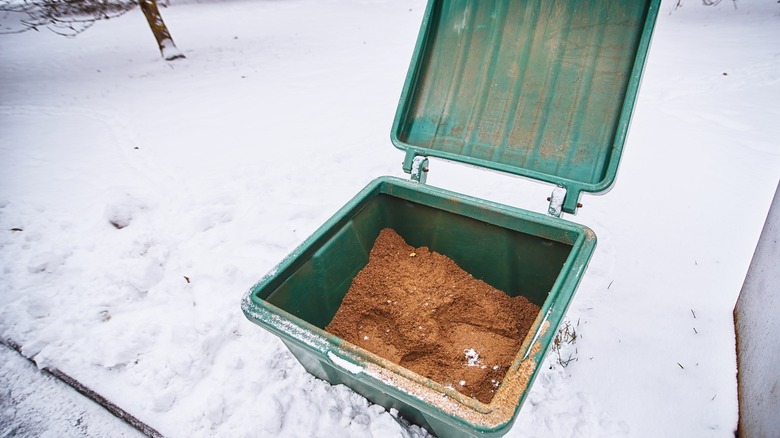This Amazing Trick Will Prevent Slippery Patio And Pathway Disasters In Winter
If you live in a place with treacherous winters, you're no stranger to the danger of slipping and falling on an icy footpath or wet patio. These spaces become death traps as they glaze over with black ice, waiting for a haphazard step from an unsuspecting victim. Luckily, any potential falling disasters can be avoided simply by treating these frequented spaces before the cold weather arrives. One such way of doing so is by applying a layer of sharp sand to the pathways.
Using sharp sand is an excellent way to prevent slipping due to its natural abrasive properties. Sharp sand, characterized by its coarse and gritty texture, provides a rough surface that improves grip, reducing the likelihood of slips and falls. This is particularly beneficial in winter when surfaces are prone to ice formation, making them slippery. When applied to patios and pathways, sharp sand creates a stable and non-slip surface. Its granular composition helps to break down ice and snow, preventing the formation of a smooth, hazardous layer. The sand's ability to interlock with the ground and ice crystals contributes to increased friction, providing a secure footing for individuals walking on these surfaces.
Additionally, it's a less toxic alternative to chemical de-icing agents, which may have adverse effects on plants and soil. By incorporating sharp sand into winter maintenance practices, homeowners can create a safer outdoor environment, reducing the risk of accidents and injuries associated with slippery surfaces during cold weather.
Where to buy and how to apply
To purchase sharp sand to prevent pathways from becoming slippery during the winter months, you can explore various options, with home improvement stores and garden centers being primary sources. Large chain stores such as Home Depot often carry bags of sharp sand in their gardening or building materials sections. For $42.95, they have a 20 pound bag suitable for covering your slip zones. Local garden centers and nurseries are also reliable places to find sharp sand and may have cheaper options if you're willing to buy it by the yard.
Once you've acquired the sharp sand, the application process is straightforward. Begin by clearing the pathway of any debris, leaves, or snow. Ensure that the surface is clean and dry before spreading the sharp sand. For optimal results, evenly distribute a layer of sharp sand along the entire pathway. Use a shovel, rake, or simply your hands to spread the sand, paying extra attention to areas prone to ice formation or heavy foot traffic.
It's advisable to focus on key areas such as entrance points, corners, and slopes, where slipping hazards are more prevalent. The goal is to create a consistent and well-distributed layer of sharp sand, maximizing its effectiveness in enhancing traction. Regularly monitor the pathway throughout the winter and reapply sharp sand as needed, especially after snowfall or freezing rain. This simple and cost-effective method provides an efficient solution to mitigate slipping risks, promoting safety during the colder months.
Cautions for using sand on pathways
While using sharp sand to mitigate slipping risks on pathways in winter has advantages, several drawbacks make it less than ideal in certain situations. First, sharp sand does not provide a long-lasting solution. It tends to get displaced over time due to factors like foot traffic, rain, or snow removal efforts, requiring frequent reapplication to maintain its effectiveness. This can be impractical for some individuals and may result in inconsistent coverage on the pathway, diminishing its ability to prevent slipping. Moreover, it can become costly over the course of the winter if purchasing the sand from stores like Home Depot, where each bag is $42.95.
Secondly, from an environmental standpoint, the use of sharp sand raises concerns. When applied in excessive amounts, sand can accumulate and alter the natural balance of soil and ecosystems. Over time, it may negatively impact plant growth, water quality, and local wildlife. Additionally, the extraction and transportation of sand contribute to habitat disruption and can lead to erosion of coastal areas. Often sourced from quarries or dredged from rivers, this extraction process can harm ecosystems, leading to habitat destruction and loss of biodiversity. It can also result in soil erosion and sedimentation, negatively affecting water quality in nearby areas. So, while it's important to remain safe in and around your home throughout the winter months, it's essential to understand the origins of your sand purchases as well as their impact on the environment.


